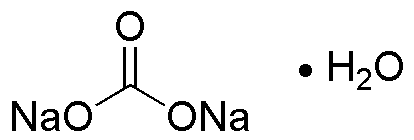Sodium carbonate monohydrate is widely utilized in research focused on:
- Glass Manufacturing: This compound is a key ingredient in the production of glass, helping to lower the melting temperature of silica, which enhances energy efficiency and reduces costs.
- Water Treatment: It plays a vital role in softening water by precipitating calcium and magnesium ions, making it essential for industries that require high-quality water, such as food and beverage production.
- pH Regulation: In laboratories, it is commonly used to maintain alkaline conditions in various chemical reactions, ensuring optimal performance and accuracy in experiments.
- Textile Industry: Sodium carbonate monohydrate is employed in dyeing processes to help fix dyes to fabrics, improving color retention and vibrancy in textiles.
- Cleaning Products: Its effectiveness as a mild abrasive and a pH regulator makes it a popular ingredient in household and industrial cleaning agents, providing a safer alternative to harsher chemicals.
General Information
Properties
Safety and Regulations
Applications
Sodium carbonate monohydrate is widely utilized in research focused on:
- Glass Manufacturing: This compound is a key ingredient in the production of glass, helping to lower the melting temperature of silica, which enhances energy efficiency and reduces costs.
- Water Treatment: It plays a vital role in softening water by precipitating calcium and magnesium ions, making it essential for industries that require high-quality water, such as food and beverage production.
- pH Regulation: In laboratories, it is commonly used to maintain alkaline conditions in various chemical reactions, ensuring optimal performance and accuracy in experiments.
- Textile Industry: Sodium carbonate monohydrate is employed in dyeing processes to help fix dyes to fabrics, improving color retention and vibrancy in textiles.
- Cleaning Products: Its effectiveness as a mild abrasive and a pH regulator makes it a popular ingredient in household and industrial cleaning agents, providing a safer alternative to harsher chemicals.
Documents
Safety Data Sheets (SDS)
The SDS provides comprehensive safety information on handling, storage, and disposal of the product.
Product Specification (PS)
The PS provides a comprehensive breakdown of the product’s properties, including chemical composition, physical state, purity, and storage requirements. It also details acceptable quality ranges and the product's intended applications.
Certificates of Analysis (COA)
Search for Certificates of Analysis (COA) by entering the products Lot Number. Lot and Batch Numbers can be found on a product’s label following the words ‘Lot’ or ‘Batch’.
*Catalog Number
*Lot Number
Certificates Of Origin (COO)
This COO confirms the country where the product was manufactured, and also details the materials and components used in it and whether it is derived from natural, synthetic, or other specific sources. This certificate may be required for customs, trade, and regulatory compliance.
*Catalog Number
*Lot Number
Safety Data Sheets (SDS)
The SDS provides comprehensive safety information on handling, storage, and disposal of the product.
DownloadProduct Specification (PS)
The PS provides a comprehensive breakdown of the product’s properties, including chemical composition, physical state, purity, and storage requirements. It also details acceptable quality ranges and the product's intended applications.
DownloadCertificates of Analysis (COA)
Search for Certificates of Analysis (COA) by entering the products Lot Number. Lot and Batch Numbers can be found on a product’s label following the words ‘Lot’ or ‘Batch’.
*Catalog Number
*Lot Number
Certificates Of Origin (COO)
This COO confirms the country where the product was manufactured, and also details the materials and components used in it and whether it is derived from natural, synthetic, or other specific sources. This certificate may be required for customs, trade, and regulatory compliance.

